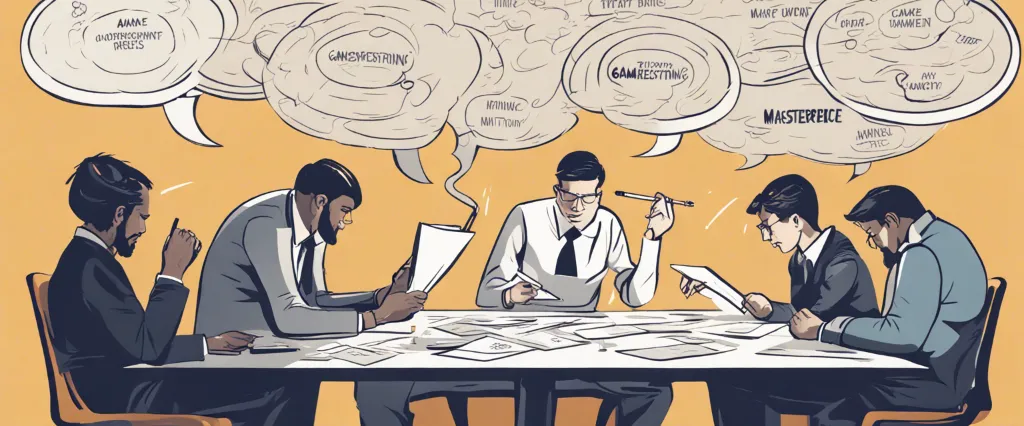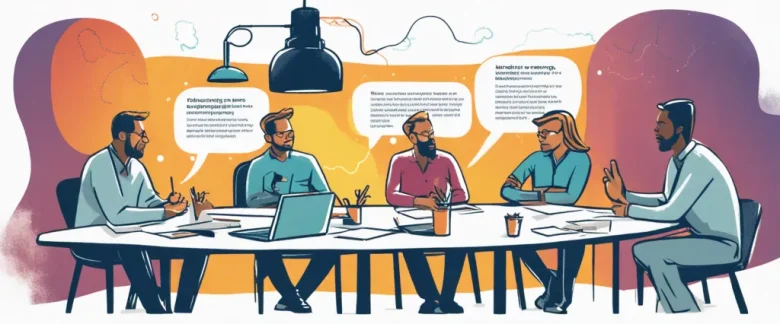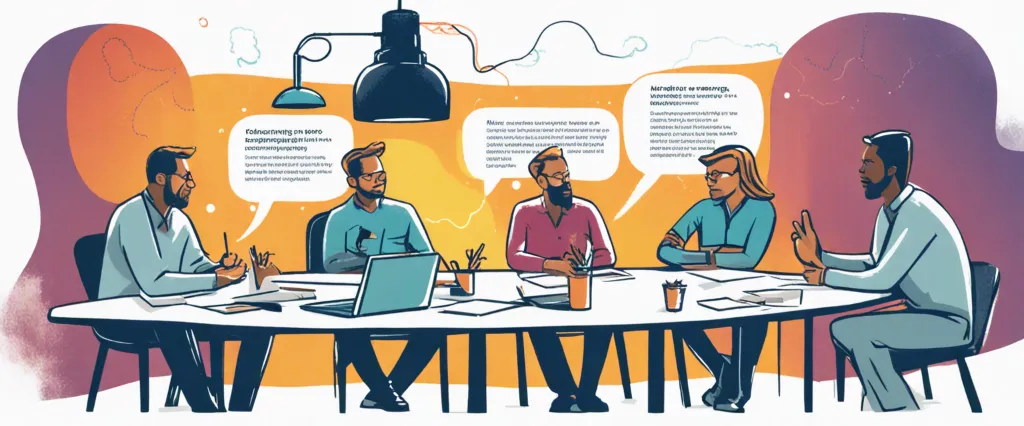In the transformative world of business, where traditional methods are increasingly rendered ineffective, Gamestorming by Dave Gray stands as a guidebook to cultivate innovation, collaboration, and creativity within organizations. This highly acclaimed book unveils a formidable collection of techniques and approaches that foster fresh thinking and problem-solving by engaging teams through interactive games. With a wealth of practical examples and insightful anecdotes, Gray equips readers with the tools to navigate dynamic environments, enabling them to generate breakthrough ideas, unlock hidden potential, and embrace change. As the founder of XPLANE, a renowned visual thinking consultancy, Dave Gray is a prominent figure in the realm of strategic business design. He is recognized for his expertise in helping organizations flourish in ambiguous and complex landscapes by employing visual thinking and game-like approaches. With a keen eye for innovation and a deep understanding of the importance of creative collaboration, Gray has become a leading advocate for transformative practices in the business world.
Chapter 1:Unlocking creativity through collaborative and interactive techniques
Chapter 1 of “Gamestorming: A Playbook for Innovators, Rulebreakers, and Changemakers” by Dave Gray focuses on unlocking creativity through collaborative and interactive techniques. The chapter highlights the importance of engaging and involving multiple perspectives to solve complex problems, generate innovative ideas, and foster a culture of creativity.
The chapter begins by explaining the concept of gamestorming, which is inspired by the idea that games have inherent qualities that can be applied to problem-solving and creative thinking. Gamestorming involves using various game-like activities and methods to tap into people’s creativity and encourage collaboration. The author emphasizes that gamestorming is not just about playing games but rather about harnessing the power of games to enhance the creative process.
The chapter introduces key principles to guide gamestorming sessions, such as focusing on people first, nurturing a safe and inclusive environment, creating space for exploration and experimentation, and recognizing the importance of diversity in ideas and perspectives. Gray believes that by incorporating these principles, teams can unlock their collective intelligence and achieve breakthrough solutions.
The author presents and delves into several gamestorming techniques throughout the chapter. Some of these techniques include “Show and Tell,” which involves sharing and presenting ideas to gather feedback and insights, “Empathy Map,” a tool for understanding user experiences and perspectives, and “Visual Collaboration,” which encourages participants to express and develop ideas through visual elements.
Furthermore, Gray recommends combining different gamestorming techniques to address different stages of the creative process, such as problem framing, idea generation, and decision-making. The chapter stresses the importance of adaptability and customization of gamestorming techniques to suit specific contexts and objectives.
In summary, Chapter 1 of “Gamestorming” sets the foundation for unlocking creativity through collaborative and interactive techniques. It introduces the concept of gamestorming, outlines key principles, and presents various techniques that teams can utilize to foster creativity, innovation, and effective problem-solving.
Chapter 2: Designing engaging and effective brainstorming sessions
Chapter 2 of the book “Gamestorming” by Dave Gray focuses on designing engaging and effective brainstorming sessions. The chapter begins by stressing the significance of preparation and setting clear goals before diving into a brainstorming session. Gray emphasizes that brainstorming is most effective when it has a clear purpose and specific parameters.
The chapter introduces several gamestorming techniques to enhance brainstorming sessions. Techniques such as “Remember the Future” encourage participants to imagine a successful outcome and work backward to identify the steps needed to reach that outcome. This approach helps participants think creatively and consider new possibilities.
Gray also introduces the “SWOT Analysis” technique, where participants list the strengths, weaknesses, opportunities, and threats of a particular situation or idea. This technique provides a structured framework to identify the potential challenges and advantages of different options.
The chapter explains the importance of creating a safe and inclusive environment during brainstorming sessions. Gray suggests using games and icebreakers to establish trust among participants and foster collaboration. He also emphasizes the value of diverse perspectives, encouraging facilitators to involve a range of stakeholders to generate a broader set of ideas.
Additionally, the chapter provides insights into the role of the facilitator. Gray advises facilitators to avoid dominating the session and instead focus on guiding and encouraging active participation from all attendees. He emphasizes the need to promote a positive group dynamics and manage potential conflicts.
Overall, Chapter 2 of “Gamestorming” offers a comprehensive guide to designing engaging and effective brainstorming sessions. It highlights the importance of clear goals, introduces diverse gamestorming techniques, emphasizes the significance of an inclusive environment, and provides guidance for facilitators to maximize the value of brainstorming sessions.
Chapter 3:Using visual thinking to enhance communication and problem-solving
Chapter 3 of “Gamestorming” by Dave Gray focuses on the power of visual thinking in enhancing communication and problem-solving. The author emphasizes that visual tools have a unique ability to engage people at a deeper level and facilitate clearer understanding among team members.
The chapter begins by highlighting the importance of actively involving visual representation in meetings and brainstorming sessions. Visual thinking helps to create a shared understanding amongst participants by providing a concrete way to engage with ideas. The author introduces the concept of “visual grammar,” which includes various techniques such as sketching, creating diagrams, and using sticky notes to visually capture thoughts and ideas.
One of the key techniques discussed in the chapter is the “Empathy Map,” a visual tool that helps teams understand the needs, desires, and experiences of their customers or users. By visually mapping out different aspects, such as what the user might say, think, feel, or do, teams can gain deeper insights and design better solutions.
Another visualization technique covered is the “Business Model Canvas,” which provides a framework for capturing and analyzing the key components of a business. This tool enables teams to visually assess and refine their business strategies, considering different factors such as value propositions, customer segments, and revenue streams.
The chapter also explores the concept of “visual language” and the importance of developing a common visual vocabulary within teams. This shared understanding of visual symbols and metaphors enhances communication, allowing team members to express complex ideas visually and more effectively collaborate.
In conclusion, Chapter 3 of “Gamestorming” emphasizes the significant role of visual thinking in communication and problem-solving. By incorporating visual tools and techniques, teams can enhance their understanding, stimulate creativity, and foster better collaboration.
Chapter 4:Applying game mechanics to drive innovation and collaboration

Chapter 4 of “Gamestorming” by Dave Gray focuses on the application of game mechanics to drive innovation and collaboration.
The chapter begins by highlighting the benefits of using game mechanics in problem-solving processes. Games create a safe environment where participants can experiment, take risks, and learn from failure. They promote engagement, motivation, and creativity, which are crucial elements for innovation. By incorporating game mechanics into collaborative sessions, teams can explore new perspectives, think more expansively, and generate breakthrough ideas.
The chapter introduces several gamestorming tools that leverage game mechanics to enhance innovation and collaboration. These tools include “Prune the Future,” a game that helps identify and remove obstacles hindering progress; “Who Do You Want Your Customers to Become?” which prompts teams to envision their customers’ desired transformation; and “World Café,” a method that promotes meaningful conversations in a relaxed setting to generate innovative ideas.
It emphasizes the importance of incorporating competition and rewards into these games to further stimulate creativity and motivation. Game mechanics like points, badges, and leaderboards can be utilized to create a sense of achievement, drive participation, and foster healthy competition among team members.
Furthermore, the chapter offers various tips and advice for applying game mechanics effectively. It emphasizes the importance of creating a clear goal, defining rules and constraints, and providing immediate feedback. The chapter also stresses the significance of balancing competition with collaboration, ensuring equal participation, and designing games with varying levels of difficulty to cater to different skill levels.
Overall, Chapter 4 of “Gamestorming” provides insights into how game mechanics can be used to drive innovation and collaboration, by creating an engaging and immersive environment that encourages experimentation, creativity, and teamwork.
Chapter 5:Facilitating productive meetings and workshops
Chapter 5 of “Gamestorming” by Dave Gray focuses on facilitating productive meetings and workshops. It explores various techniques and strategies to engage participants, encourage collaboration, and generate meaningful outcomes.
The chapter starts by emphasizing the importance of setting clear goals and objectives for a meeting or workshop. It suggests using visual agendas, which provide a visual representation of the topics and activities planned, helping participants understand the purpose of the gathering. Visual agendas keep everyone aligned and focused throughout the session.
The author introduces the concept of a “meeting canvas,” a framework that enables facilitators to structure and plan their sessions effectively. It consists of several key elements such as objectives, participants, activities, and constraints. By filling out these details, facilitators can create a blueprint that ensures a well-organized and purposeful gathering.
Gray then delves into various techniques to engage participants actively. One such tactic is “Dot Voting,” where participants are provided with a limited number of sticky dots to vote on ideas or solutions. This technique promotes a democratic approach to decision-making and prioritization, allowing everyone to have a say.
The chapter further explores the importance of creating a safe and inclusive environment, where individuals feel comfortable expressing their ideas and opinions. Techniques such as “Check-In,” where participants share their current state of mind or feelings, and “Pair-Shares,” which encourages participants to discuss thoughts in small groups, contribute to fostering a collaborative and supportive atmosphere.
To conclude, Chapter 5 offers practical guidance on how to facilitate productive meetings and workshops. By setting clear goals, utilizing visual tools, promoting active engagement, and creating an inclusive environment, facilitators can ensure that participants are fully engaged, resulting in valuable outcomes and collaborative success.
Chapter 6:Harnessing the power of storytelling and visualization for ideation
In Chapter 6 of “Gamestorming” by Dave Gray, the focus shifts towards the power of storytelling and visualization as effective techniques for ideation. The chapter explores different activities and games that can be utilized to unleash the creative potential of teams and individuals.
The chapter starts by emphasizing the significance of storytelling in human culture and its ability to engage people emotionally. It explains how storytelling can be used in a business context to communicate ideas, shape concepts, and inspire action. The chapter highlights that storytelling should be simple, authentic, and relatable, resonating with the audience’s values and experiences.
Gray then introduces visualization as a powerful tool that helps unlock creativity and promote a visual language for ideation. He acknowledges that not everyone is naturally adept at drawing, but encourages readers to embrace simple sketches and visual representations to enhance communication and generate ideas.
Several games and exercises are introduced in this chapter. For example, “User Hero” is a storytelling activity where participants are encouraged to imagine and share their experiences as a “hero” using products or services. This exercise helps uncover unmet needs and generate new ideas through empathy-driven narratives.
Another technique shared is “The Visual Game,” which involves drawing and visualizing metaphors to explore concepts and generate ideas. Participants are asked to draw visuals that represent a given topic, challenging them to think beyond words and tap into their visual thinking abilities.
Overall, Chapter 6 of “Gamestorming” outlines the importance of storytelling and visualization as powerful tools for ideation. By integrating these techniques into collaborative activities, teams can enhance creativity, empathy, and communication, resulting in more innovative and impactful ideas.
Chapter 7:Integrating play and experimentation into work processes
Chapter 7 of “Gamestorming: A Playbook for Innovators, Rulebreakers, and Changemakers” by Dave Gray focuses on integrating play and experimentation into work processes. The chapter emphasizes the importance of incorporating interactive and dynamic methods into problem-solving and decision-making within organizations.
The author suggests that introducing elements of play can enhance creativity, engagement, and collaboration among team members. Play allows individuals to approach challenges with a sense of curiosity, exploration, and a willingness to take risks. It helps to create a safe environment where people can freely express their ideas without fear of criticism or failure.
The chapter introduces various gamestorming techniques that can be used to infuse playfulness into work processes. These techniques include visualization games, storytelling exercises, brainstorming sessions, and role-playing simulations. By integrating these games into meetings or workshops, team members can unlock their creativity, generate fresh ideas, and improve communication and collaboration.
Additionally, the chapter addresses the importance of experimentation in the workplace. It discusses the need for a culture that encourages and supports rapid prototyping and learning from failures. Experimentation allows teams to test and validate ideas quickly, enabling them to adapt and refine their approaches based on real-world feedback. It promotes a mindset of continuous improvement and innovation within an organization.
Overall, Chapter 7 highlights the value of incorporating play and experimentation into work processes. By adopting these methods, organizations can create a more dynamic and innovative work environment, fostering creativity, collaboration, and growth.

Chapter 8: Empowering teams to generate breakthrough ideas and solutions
Chapter 8 of “Gamestorming” by Dave Gray explores the idea of empowering teams to generate breakthrough ideas and solutions. The chapter emphasizes the importance of creating a supportive environment that encourages team members to think outside the box and challenge traditional norms.
The chapter begins by highlighting the role of culture in fostering innovation within teams. It discusses how organizations can create a safe and open space for employees to share their ideas, while also providing a platform for collaboration and experimentation. Gray suggests that team leaders should adopt a mindset of curiosity, actively seeking out diverse perspectives and out-of-the-box thinking.
The chapter then introduces several gamestorming techniques that can be used to generate breakthrough ideas. These techniques include “Stack the Deck,” which involves identifying the most valuable ideas in a list and determining ways to prioritize and execute them effectively. Another technique, called “Imagine Your Future,” prompts team members to envision the desired outcome and work backward to build a strategy to achieve it. “Converge and Diverge” is a method that encourages divergent thinking during idea generation and then converging on the most promising solutions.
Gray also highlights the importance of creating a safe space for feedback and critique. He suggests utilizing techniques like “Four Ls” (Liked, Learned, Lacked, and Longed For) to encourage constructive feedback and improve the overall quality of ideas.
In conclusion, Chapter 8 of “Gamestorming” emphasizes the significance of fostering an innovative culture within teams. By using various gamestorming techniques and creating an environment that encourages open communication, teams can generate breakthrough ideas and find innovative solutions to complex problems.
After Reading
In conclusion, “Gamestorming” by Dave Gray is a comprehensive guide to using games and visual thinking techniques to bring about innovation, collaboration, and creativity in various professional settings. The book provides a wide range of game-based activities, tools, and strategies that can be applied by individuals, teams, and organizations to overcome challenges, generate ideas, and solve complex problems. Gray emphasizes the importance of play and experimentation as catalysts for breakthrough thinking, and highlights the power of visual communication in fostering better understanding and engagement. Overall, “Gamestorming” offers a practical and engaging approach to transforming the way we work and think, ultimately unlocking the potential of both individuals and teams in unleashing their creativity and achieving meaningful results.
1. “Design Sprint: A Practical Guidebook for Building Great Digital Products” by Richard Banfield, C Todd Lombardo, and Trace Wax: This book offers practical strategies and techniques for running design sprints, a five-day process for tackling challenges and finding solutions. It provides hands-on methods to facilitate collaboration, decision-making, and innovation within teams.
2. “The Art of Innovation: Lessons in Creativity from IDEO, America’s Leading Design Firm” by Tom Kelley and Jonathan Littman: Written by IDEO’s founder and a journalist, this book explores how IDEO revolutionized the field of product design through a human-centered approach. It highlights their creative problem-solving methods and insights, inspiring readers to adopt a similar mindset.
3. “Visual Meetings: How Graphics, Sticky Notes, and Idea Mapping Can Transform Group Productivity” by David Sibbet explores the power of visual thinking in meetings and workshops. It presents practical tools and techniques to enhance communication, foster creativity, and improve group productivity through visual collaboration.
4. “The Innovation Expedition: A Visual Toolkit to Start Innovation” by Gijs van Wulfen offers a step-by-step guide to ignite innovation. It provides a visual toolkit and practical methods to explore new ideas, engage stakeholders, and navigate the innovation journey successfully.
5. “The Design Studio Method: Creative Problem Solving with UX Sketching” by Brian K. Sullivan introduces a collaborative approach to UX design. It provides practical techniques for sketching and prototyping, enabling teams to generate innovative solutions and deliver exceptional user experiences.




